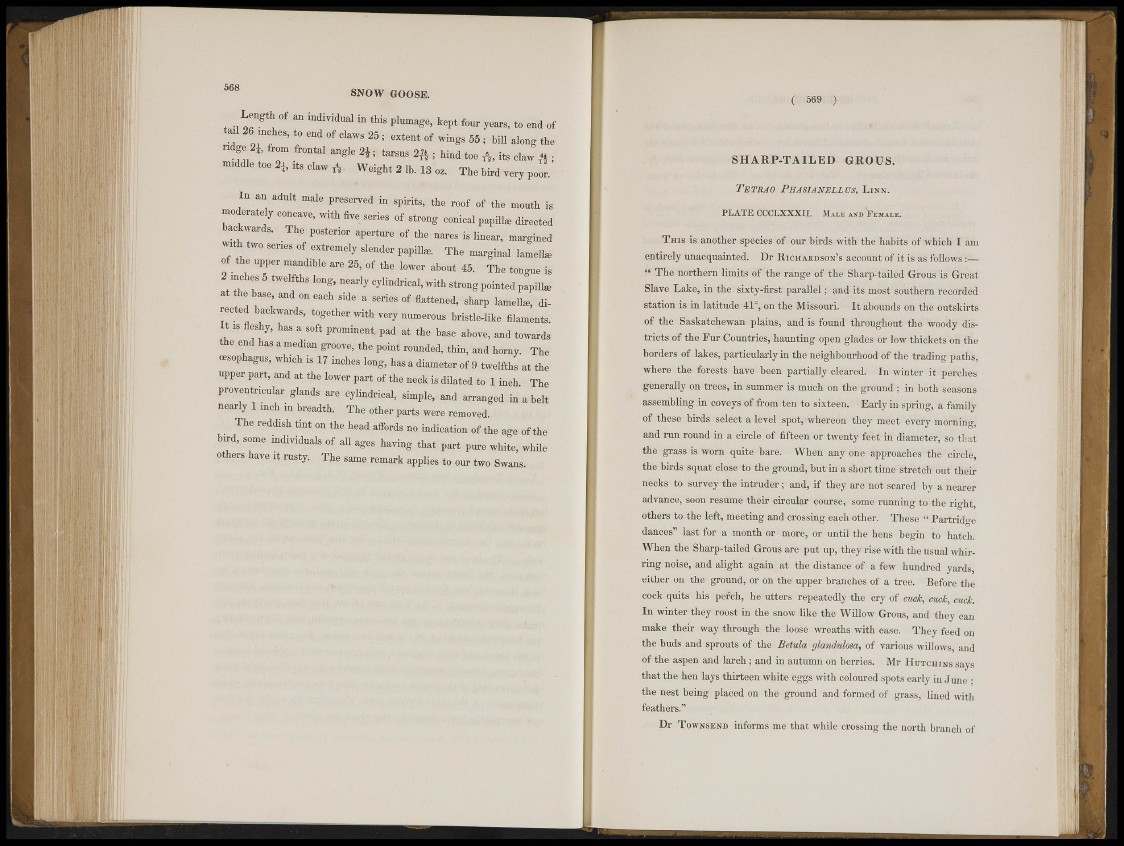
SNOW GOOSE.
I • H B B ^ H W B 1
I B H H « « E H ; bill along the
H frontal MM 2 J , M ¿ft . hind to(, ^ • •
m i d d f c t o«2|, its claw l V Weight 2 U, 13 02. The bird very p e l
I a", a d u l t ma''" in spirits, the roof of the mouth is
- nioderately eaneaif%, with five: series of strong corneal papilte directed
backwards. The posterior aperture Mf the „»res is linear,, Margined
two. series of: extremely slender p a » » The marginal lamell*
Of the upper mandible are 25, of the lower about 45. The tongue i s
• B t M s S H I cylindrical^ with strong pointed papill.
at the base, aad « each side a. series of flattened, sharp lamella, directed
backwards, together with very numerous bristle-lite filamenfe
It »fleshy, has a soft prominent, pad at the base above, and towards
the. # r t , has a median groove, the point rounded, thin, and hoffiy The
oesophagus, which is 17 inches,teng, has a.diameter of.9 twelfths at the
upper part, and at the lower part of the neck is dilated to 1 inch The
provenlrieular glands are cylindrical, simple,, and arranged in a belt
nearly % inch in breadth. : The other part, were r,.moved -'
The reddish tint on the head aifords no indicaWof the age of the
b«d, some individuals of all ages haying that; part pure white, while
Others, have it rusty. The same remark applies to our two Swans.
(: 569 »af»
S H A R P - T A I L E D GROUS.
Tetrad I'iiasjaxju.i,us, Lijsx.
PLATE OOCLXXXII. Male AKD FEMALE.
THIS is another species of our birds with the habits of which I am
entirely unacquainted. Dr RICHAKDSOK'S aceouttt-OF it is as follows JB-
" The northern limits of the range of the Sharp-tailed Grous is Great
Slave Lake, in the: , sixty-first parallel; and its most southern recorded
station is in latitude 41°, ¡on the Missouri. It abounds on the outskirts
of the Saskatchewan plains, and is found throughout the woody districts
of the Fur Countries, haunting open glades or low thickets on the
borders of lakes; particularly in the neighbourhoodof the trading paths,
where the forests have been partially cleared. In winter it perches
generally on trees, in summer is much on the ground ; in both seasons
assembling in coveySof from ten to sixteen. Early in spring, a family
of these birds select a level jSpBtj -whereon they meet every morning,
and run round in a circle of fifteeffilor twenty feet in diameter, so that
the grass is worn quite bare. When any one approaches the circle,
the birds squat close to the ground, but in a short time stretch out their
necks to survey the intruder; and, if they are not: scared by a nearer
advance, soon resume their circular course, some running to the right,
others to the left, meeting and crossing each other. These " Partridge
dances'1 last for a month or morej or until the hens begin to hatch.
When the Sharp-tailed Grous are put upi they rise with the usual whirring
noise, and alight again at the distance of a few hundred yards,
either on the ground, or on the upper branches of a tree. Before the
cock quits his pefch, he utters repeatedly the ery of cuck, cuok, tmck
In winter they roost in the snow like the Willow Grous, and they can
make their way through the loose wreaths with ease. They feed on
the buds and sprouts of the Betula glancMom, of various willows, and
of the aspen and larch; and in autumn on berries. Mr HCTCHINS says
that the hen lays thirteen white eggs with coloured spots early in June •
the nest being placed on the ground and formed of grass, lined with
feathers."
Dr TOWNSEND informs me that while crossing the north branch of